Seeing Things??
A Little Psychoactive Merry Making
It’s hard to know what’s real with the firehose of news and views spraying us with often repeated, but little researched claims and “facts”. New forms of communication and AI technology increase the chances that we could be seeing things that aren’t really there.
Some old timey herbal products could supply an alternate reality, perhaps at a more tolerable or even pleasant pace. Some of these delightful, natural products are used traditionally at this Winter holiday time of year, and might be useful for accentuating, for example, Christmas and New Year’s cheer.
Let’s slow down our pace, take a break from the crisis treadmill, and go on a treasure hunt for some kitchen hallucinogens. We can ascertain just how much is required to take a trip without leaving home, and whether or not this is likely to happen ‘serendipitously’ ;-)
First holiday stop is the Nutmeg! Myristica fragrans is an evergreen tree found in Indonesia which produces 2 spices:
mace from the web-like seed covering (aril)
nutmeg from the seeds which take a month and a half or more to dry.
The thin outer shell of the seed is quite hard, but once you pound through that, the inside is somewhat cork-like in texture. The scent is a whole array of spicy midnotes plus citrusy topnotes. This nutmeg is the amazing product which floats upon the head of eggnog in the holiday season, and is one of the pumpkin spices flavoring the addictive lattes and desserts that have burst out of their season and preoccupy many palates year round. For top pungency, shave or grind the nutmeg seeds right before using the spice. Those who like a lot of nutmeg have noticed that it does more than enhance the flavor of holiday goodies. Getting a dose above 1 gram starts to elevate the mood, and alter the perception of reality a bit. This effect reportedly has slow onset, and increases and recedes in waves. It’s highly variable and the freshly ground nutmeg seeds of the Indonesian Myristica fragrans seem more potent in producing CNS effects. Some of this is thought to be a result of metabolic transformations of myristicin to psychotropic compounds, but studies of this isolated compound indicate that it doesn’t account for all the hallucinatory effects of nutmeg. Elemicin is another possible active ingredient, and does seem to have activity on 5HT receptors in the CNS, and some mood elevating effects.
The slow onset of nutmeg psychoactivity tends to cause a bit of trouble with the dosing, as people get impatient and decide to take more. Higher doses increase the possible delirium and the duration of action. A low or threshold dose (3-5 grams) might take 6 hours to reach a first peak effect, and return to baseline at 18 hours. Moderate to high doses 10-20 grams could possibly take up your whole weekend, plus another day or 3 of hangover. 25 grams and higher increase chances of a trip to the ER, where supportive care might be given for panic and a bad trip, but usually not for toxicity. Rarely drug interactions have caused enhanced toxicity and death in a couple cases.
People have sought to enhance the effect of nutmeg by combining it with cayenne, which inhibits a liver enzyme Cyp2E1, The piperine in black pepper, seems also to potentiate such natural products in many cases.
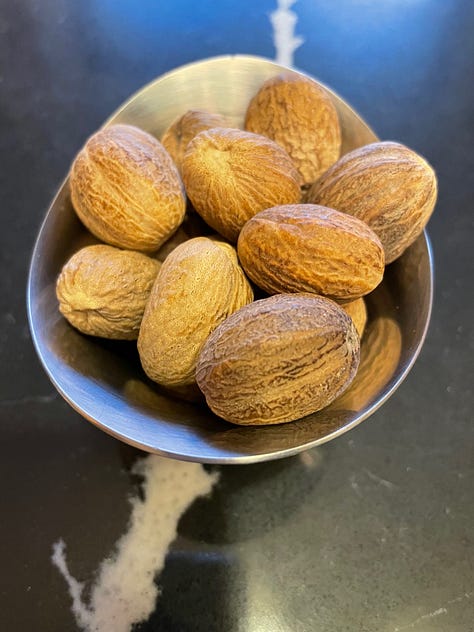

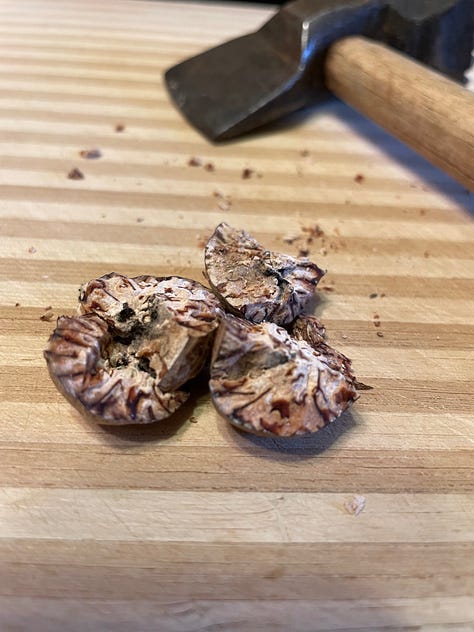
Ibo Nagano in the Entheogen review reports on 2 interesting recipes which seem to increase the effectiveness and perhaps palatability of higher dose nutmeg. The first recipe, Space Paste, combines tablespoon sized “parts” of the following, and a dose of 2 tablespoons of the mixture (containing only a teaspoonful of nutmeg) is claimed to be similar to a marijuana brownie, and reportedly can cause hallucinations. (This illustrates significant potentiation and CNS effects available from kitchen compounding, and is not a recommendation. )
4 parts nutmeg (ground from whole nutmeg)
4 parts almonds (soak overnight and rinse)
4 parts raw pistachios
2 parts cinnamon
1 part cumin
1 part tarragon
1 part oregano
1 part basil
1 part turmeric
1/2 part cayenne pepper
1/2 part black pepper
maple syrup (to taste)
The next recipe, adapted by Nagano is for some happy, spicy cookies, each of which will deliver a much lower dose of nutmeg that wouldn’t normally be an issue unless you really binge….. in which case, you’re on your own. :-D
2 Tbsp ground nutmeg
2 Tbsp ground cinnamon
1.5 tsp ground cloves
3 cups flour
3/4 cup sugar
2 sticks (1 cup) of butter
2 eggs
pinch salt
3/4 cup chopped almonds
Mix and deliver spoonfuls to a cookie sheet and bake at 350F for 5-10 min. Cookies are said to provide something better for the mood than a sugar buzz, and perhaps will induce couples to be chasing each other around the house.
Like catnip, nutmeg has been experimentally observed to enhance sexual activity in rats, and the increased mating behaviors seemed independent of actual ability to get the entire job done. This seems to corroborate the traditional, medicinal use of the spice as an aphrodisiac.
Next stop is the time honored Absinthe liquor which was subjected to a ban of 70 plus years, (duration varied by country). This group of alcoholic beverages is said to have begun with a French physician Pierre Ordinaire who compounded and sold wormwood elixirs. Some say that Henriette Henriod sold him the recipe. Others say the Henriod sisters sold the recipes to Daniel-Henri Dubied who opened up production with his son-in-law Henri-Louis Pernod in Switzerland, and later in Pontarlier, France.
Numerous recipes for absinthe have proliferated. At the core of some traditional concoctions were 2 successive macerations of herbs and spices coupled with distillation processes. The first maceration contained Artemisia absinthium, grande wormwood, (250 grams dried product per liter) with various spices, and the second maceration contained additional spices, and Artemisia pontica, Roman wormwood, (100 grams dried product per liter) which contributed more chlorophyll to the green color. Other herbal and spice products (e.g. anise, coriander, hyssop, lemon balm, angelica, licorice, etc. were added in the maceration steps to hide some of the taste of wormwood’s absinthin, one of the most bitter compounds the plant world has to offer. Other Artemisia species, such as the A. abrotanum pictured below, right have made their way into the numerous possible absinthe recipes.
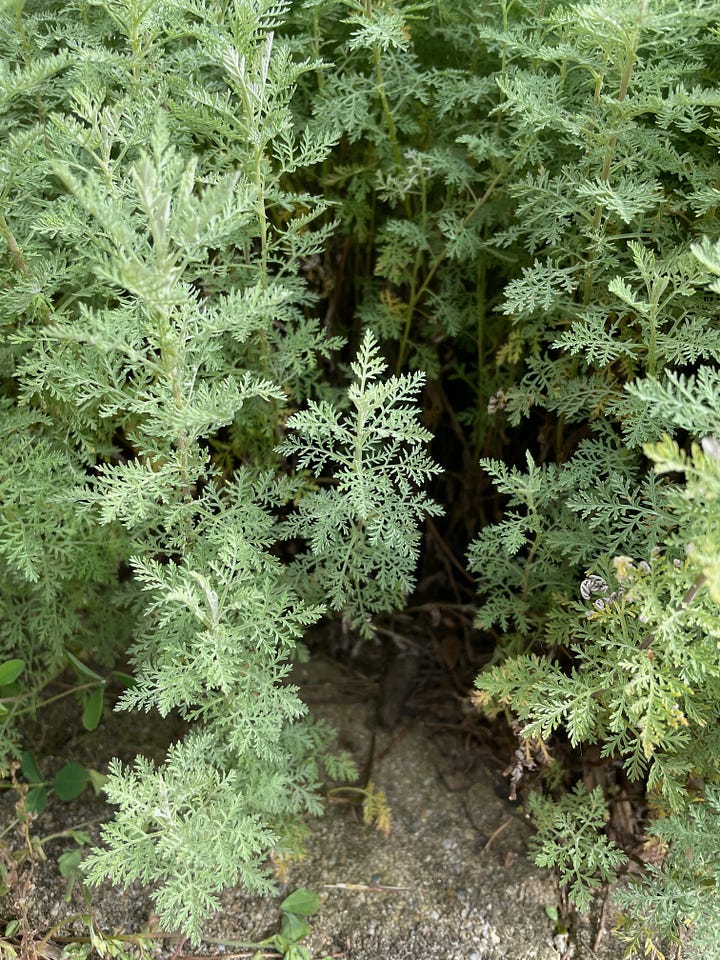
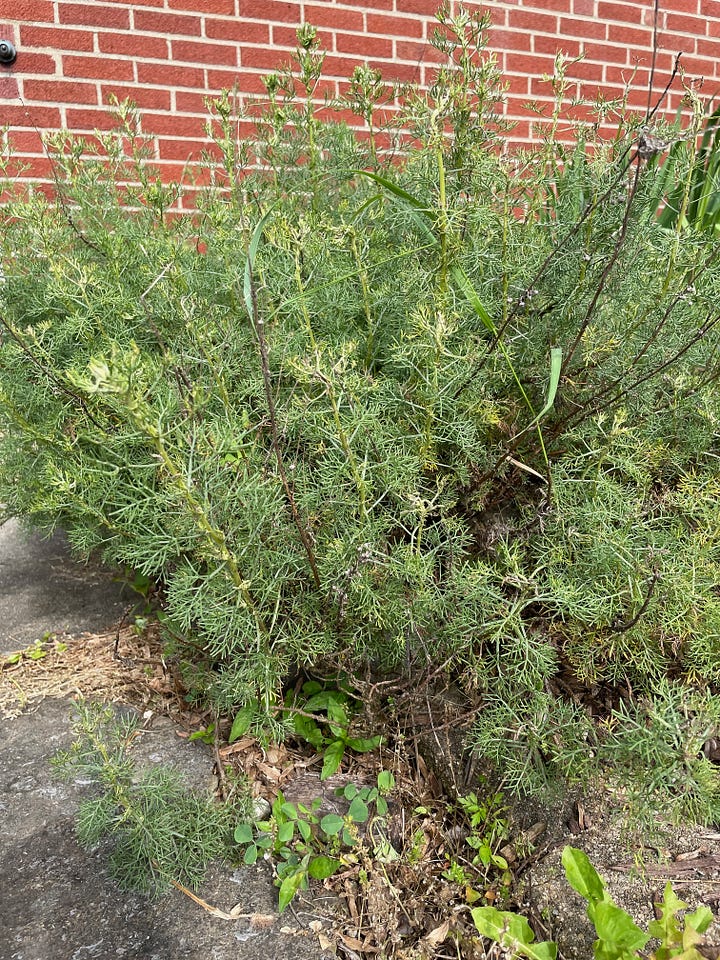
Part of what caused the initial explosion of absinthe popularity was a little mite that decimated France’s grape production in the late 1800s, thus cutting off the wine supply. The sheer volume of absinthe (70% alcohol) consumption, and resultant social problems is much more responsible than the wormwood for its banning by the temperance movements. Ethanol is more likely to have been responsible for toxicity than the small, 0.0 mg.- 260 mg. per liter concentrations of thujone that were possible, given the records of the recipes. Testing of vintage and modern absinthe concoctions, made using traditional recipes, have shown concentrations of thujone at the lowest end of that range, which are unlikely to have caused any kind of toxicity, much less the sought after psychedelia. Current U.S. standards for the amount of thujone permitted in absinthe are based upon outdated analytical techniques for quantitation, so that “no thujone” perhaps means 10 mg. per liter or less. You could get a bigger thujone experience from your garden sage, which, by the way, is not regulated at all.
(-)-alpha-Thujone a.k.a. (1S,4R)-1-Isopropyl-4-methylbicyclo[3.1.0]hexan-3-one, is a colorless, major component of the essential oils produced from diverse genera of the plant kingdom. This isomer of thujone is 2-3 times more potent than the less stable beta isomer that accompanies it, and is therefore recognized as the CNS active component of these plants.
Pernod distillers have resumed making absinthe, and have diversified their adult beverage production, and expanded operations to numerous countries. Absinthe, then and now, likely has been much more hype than hallucination. Most such effects experienced by absinthe drinkers of the past were the delirium experienced by periods of abstinence enforced upon alcohol dependent individuals enduring shortages of supply. Absinthe has returned among today’s trendy drinkers along with complex serving rituals. For example, an ounce or so of the absinthe is added to a glass, and 3-5 ounces of chilled water might be added by pouring over a sugar cube placed above the glass on a slotted spoon. This optimally causes water insoluble terpenoid compounds to precipitate out of the absinthe mixture, creating a hazy “louch” effect in the drink.
Compensating for the dearth of thujone in absinthe are the concentrated, essential oil extracts of wormwood which have exponentially higher potential to cause hallucinations as well as convulsions, renal and hepatic failure, and possible death. A single human trial suggests that a drink of 100mg/liter thujone containing beverage can produce some hallucinatory effects. There’s a single report of a man ingesting 14 ml of wormwood essential oil which caused convulsions, rhabdomyolysis and acute renal failure. His dose was on the order of 100-500 times the dose reported to elicit mild hallucinatory effects. The convulsant effect of high-dose thujone is thought to be due to blocking the GABA inhibition of chloride channels, thereby allowing (analeptic) excitatory effects in the brain. Alpha thujone is a reversible modulator of 5 HT3 receptors, which further contributes to its psychotropic effects.
Artemisia vulgaris, mugwort an invasive weed found in most temperate regions, is a wild source of thujone and other principles. While the yield of essential oil is quite low, 0.1-0.3% of dry material by hydrodistillation, that final, essential oil product is comprised of about 30% thujone. The whole herb and aqueous infusions contain only small percentages of thujone.
Salvia officinalis, common garden sage produces essential oil with similar thujone composition, almost 30%, but the essential oil yield is much higher than that of mugwort, 1.2 - 2.8%. Therefore, more available thujone is present in whole sage than in mugwort.
Yarrow, Achillea millefolium yields ~1 percent essential oil from the dry aerial parts, and it is comprised of from 0-35% thujone. Teas of the Artemisias and the Salvia species tend to be very low dose with respect to thujone. Drying any of these herbs, reduces the thujone content considerably.
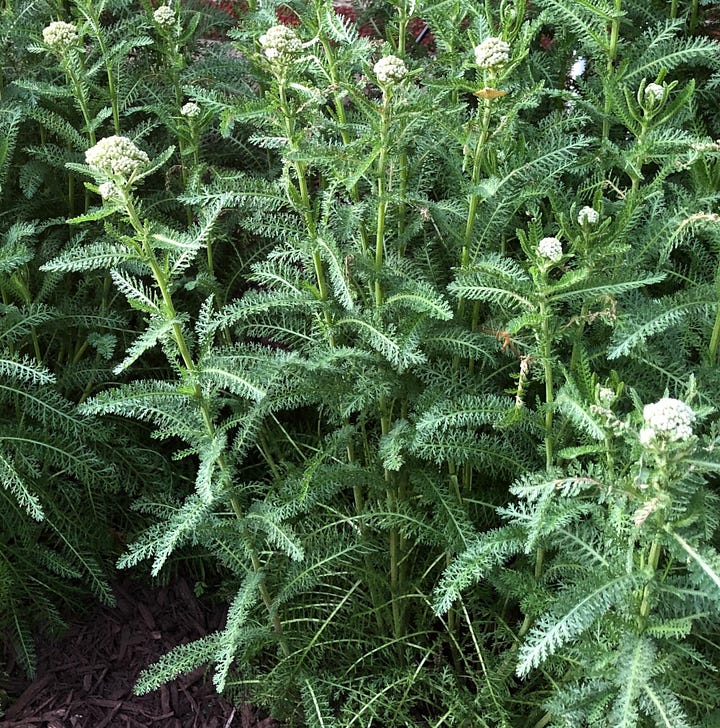
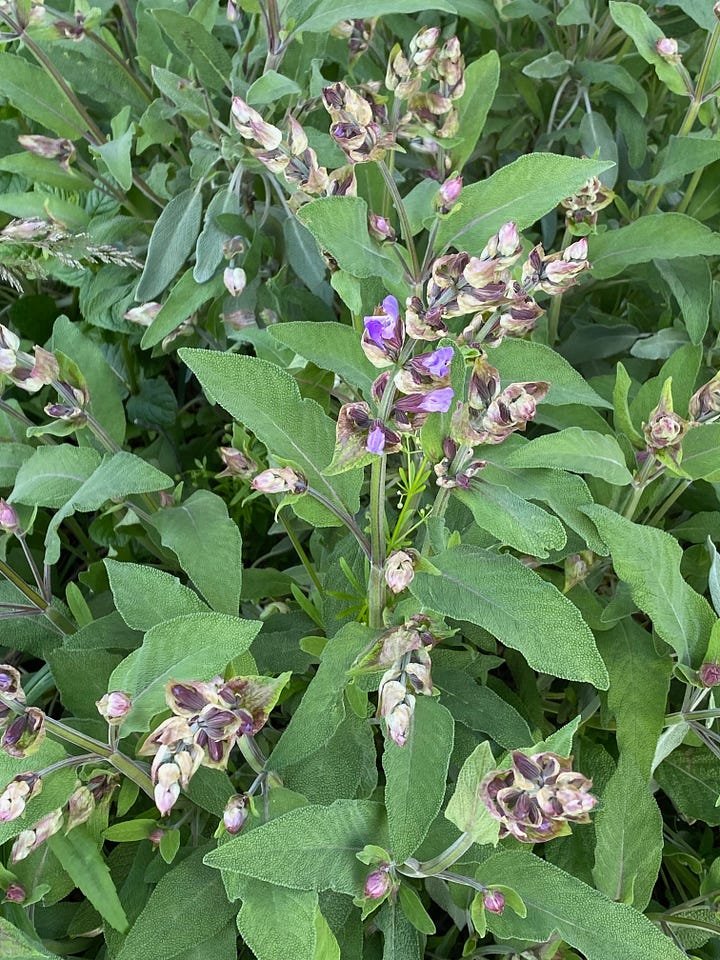
Other very prominent sources of thujone are the Red and white cedar, Thuja species, and the rather invasive tansy, Tanacetum species. People who really want to live in alternate universes have many options besides the wormwood, but should be aware of the doses possible from their chosen natural source. As always, working with the whole plants tends to provide comparatively safe, low doses, while thujone is highly concentrated in the essential oils, which must be diluted.
Pregnant women, and those who have a history of seizures are especially cautioned to avoid taking trips with nutmeg, because it is a potential uterine stimulant. The thujone containing herbs also bear this warning, as well one for those who have history of seizures, to to avoid medicinal doses which are larger than the culinary spice usage.
There will be a 2 week break at weedom for the holidays and to accomplish some necessary work. We pray for the Creator’s Blessings on you and yours, and hope you get to enjoy good time with friends and family. Thank you for spending 2023 with us!!
If you need some bathroom or bedtime reading ;-) check out some of the oldest articles from the fully open archives of Weedom. Think about getting into those seed catalogs, and plan some fun for the next growing season! See you in January!
(What happened to “WHERE WE DIG” lists of references? You’ll see these popping up again in the online version of the articles. We’re saving room for more pics and newsletter content for the emails.)



![(-)-alpha-Thujone a.k.a. (1S,4R)-1-Isopropyl-4-methylbicyclo[3.1.0]hexan-3-one, (-)-alpha-Thujone a.k.a. (1S,4R)-1-Isopropyl-4-methylbicyclo[3.1.0]hexan-3-one,](https://substackcdn.com/image/fetch/$s_!o0tx!,w_1456,c_limit,f_auto,q_auto:good,fl_progressive:steep/https%3A%2F%2Fsubstack-post-media.s3.amazonaws.com%2Fpublic%2Fimages%2F3f7078e6-ba37-4aef-a419-68d247149751_1512x1512.jpeg)


I started my first alcohol tincture this week. Will share pics once its ready for filtering. I also hope its medicinal qualities are as impressive as its colour!
Always wanted to try absinthe but I'm not much of a drinker to start with. Aussie bottle-o's sell Green Fairy.
Hello Weedom, have been away for too many months, thus only reading this post today Jan 21. A small edit from the Latinist--'artemisia vulgaris' (not vulgarus) as vulgaris is 3rd declension adjective (thus the -is ending is both masculine and feminine).